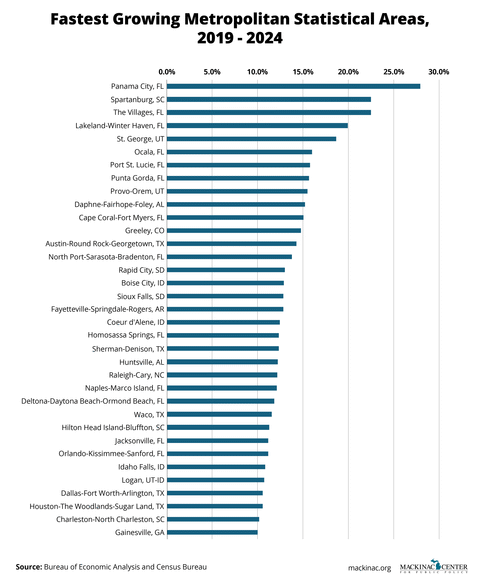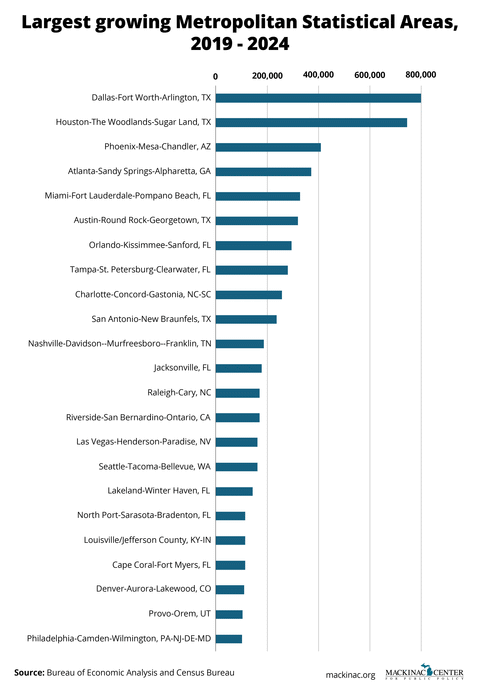Michigan’s population has been stuck in the same spot for a generation, and Gov. Gretchen Whitmer wants to change that. Her population committee delivered a report and her growth office is handing out grants to do something to attract and keep more people in the state. It’s been two years since Whitmer created her task force, and it’s time for state officials to reassess their strategy. They should start by looking at the places around the country that are growing and notice that they are not the ones you might expect.
The fastest growing Metropolitan Statistical Area is the Panama City, Florida, region. Its population increased from 176,800 people in 2019 to 226,200 in 2024, or 28%.
The next fastest growing area was Spartanburg, South Carolina. Its population increased from 323,200 to 395,900 for a 23% gain.
Other top leaders were small to mid-sized cities in Florida, Utah, Idaho, Alabama and Texas.
When we compare areas by raw numbers rather than percentages, the Dallas-Fort Worth-Arlington area grew the most, adding 798,900 people over five years. It was followed by the Houston area, at 746,200 people. The Phoenix, Atlanta, Miami, Austin, Orlanda, Tampa, Charlotte and San Antonio areas all added more than 200,000 people from 2019 to 2024.
The number of fast-growing areas in Texas raises the question of whether oil towns have an advantage. Not all do: New Orleans is also an area with heavy concentration in oil and gas industries, but it does not have the population growth of Texas. The New Orleans area population is declining and now stands at fewer than 1 million people, making it smaller than the Grand Rapids area.
People also might wonder whether an aging population explains the growth of places in warmer areas. That’s true of a place like The Villages, Florida, where the median age is 69. But that’s less so in the Panama City area, where the median age is 42, close to the national median of 39. The median age in Spartanburg is 38, and it’s 36 in both the Dallas-Fort Worth-Arlington area and the Houston area.
The growing places do not always have cheap or expensive housing. Let’s use average home sale prices as a proxy for housing affordability. The fast-growing St. George, Utah, area had a median home sale value of $561,800 in 2024, well above the $412,500 national number. But home sale prices in the fast-growing Spartanburg, South Carolina, area were well below that amount at $293,800. The Dallas, Houston and Atlanta areas were below the national median price while the Phoenix, Miami and Austin areas were above it.
High prices may also deter growth, as the Los Angeles, San Francisco and New York areas have very high home sale values and some of the largest population loses. But the Chicago area also lost a lot of people and home sales prices there are below average.
There’s one more possible explanation. Some people think a good transit system is key to attracting people. I’m not sure there’s a measure for the quality of the transit systems, but a measure from the American Community Survey on the use of transit for commuting can be a proxy for the popularity of the service. Only 1.4% of people in the Houston area use transit to commute, less than the 3.5% national average. The number is 0.7% in the Dallas area, 0.6% in the Panama City area and 0.2% in the Spartanburg area. Low and below average transit use suggests that transit is not responsible for the growth of these areas.
The fundamentals matter, however, and letting people pursue their own economic interests matters to population growth. But even then, places that do it well aren’t always growth leaders. The Fraser Institute gives Texas a high ranking for its economic liberty, and the state is home to some of the fast-growing areas. But it’s also home to the San Angelo Metropolitan Statistical Area, which lost population from 2019 to 2024.
The broader lesson is that policymakers should be humble about what they can do to foster population growth. We live in a country of 340 million and growing, and people get to figure out for themselves where they are going to live. They’re not following the direction of state lawmakers. The people Floridians elected likely did nothing special for the Panama City area to have it become the fastest growing Metropolitan Statistical Area in the country.
In other words, lawmakers ought to recognize that population growth is emergent. It is the result of millions of people making decisions to serve their own interests. Better policies —like the ones highlighted in our literature review of what matters to population growth — can help. But politicians do not command their regions to grow.











